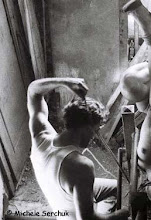
I mimicked the Klaw style (there being no real technique) for a little while before stumbling upon John “Willie” Coutts and his Gwendolyn drawings. In Willie I think western bondage finds its first true prophet. Willie’s style was not only founded on the same sort of artfully sculpted 40s - 50s Monroe curves as Klaw, but he laced those curves impossibly tightly, drawing in the waist, pulling back the elbows, pushing out the breast, lifting and separating, as it were, and elongating with stiff, angular posing and sky-high heels. In addition, Willie was shameless in his use of overwhelming and distorting gags, which displace visual and aural cues to the wearer’s personality revealed in facial and verbal gesture. I see this as enhancing the quality of mystery associated with woman, the mystery of creation, of begetting, and the messy business of generating life (a thesis elaborated here). Willie’s work was all about the reduction of the individual, particular woman, and the elevation of capital W Woman. In the pages of his Bizarre magazine, he was wont to allow occasionally that the imposition of vigorous, calculated bondage was the only cure for that hopeless intimidation felt by modern man confronted with the withering power of Woman. If he were read in philosophy (and I doubt he was – he was first an intuitive and second a drunk), Willie would probably have agreed with Nietzsche’s association of woman with the chaotic, fecund and creative Greek god Dionysus, who was balanced by the tempering, masculine-associated regulatory and managerial Apollo.
There are many theories on how and why bondage, and in particular its identifiable stylings, both eastern and western, gains formal status in the 20th century. Some posit that while photography played a large role in the break out into popular consciousness, binding for erotic effect has a far
 older history. The consensus view among aficionados seems to be that the Japanese vernacular, emerging from 15th century martial hojojitsu into what we in the west call shibari or kinbaku today, dates in its erotic manifestation to the early 19th century, but there evidence to this effect is largely apocryphal. Following Itoh Seiyu's drawings from SM-inflected kabuki dramas, the form seems fairly well-evolved when erotic kinbaku images start showing up in Japan around the late 1920s and early 1930s, right about the same time the delicate SM drawings of Carlo, Herric and Rene Giffey that influenced Willie came out in the Parisian pulps of the era. Willie may also have stumbled upon Japanese bondage imagery while exiled in Australia, but his letters tell us that in 1937 it was Carlo’s work that first came to his attention while living in Sydney†.
older history. The consensus view among aficionados seems to be that the Japanese vernacular, emerging from 15th century martial hojojitsu into what we in the west call shibari or kinbaku today, dates in its erotic manifestation to the early 19th century, but there evidence to this effect is largely apocryphal. Following Itoh Seiyu's drawings from SM-inflected kabuki dramas, the form seems fairly well-evolved when erotic kinbaku images start showing up in Japan around the late 1920s and early 1930s, right about the same time the delicate SM drawings of Carlo, Herric and Rene Giffey that influenced Willie came out in the Parisian pulps of the era. Willie may also have stumbled upon Japanese bondage imagery while exiled in Australia, but his letters tell us that in 1937 it was Carlo’s work that first came to his attention while living in Sydney†.I’d like to speculate here that the emergence of bondage as erotic on a wider scale in both east and west inheres in the culturally parallel rush to modernity. Europe and America were already deeply involved in the shrinking of distance and the building of metropolises by the turn of the 20th c., and the Japanese had mounted their own juggernaut into modernity upon Commodore Matthew Perry’s 1853 appearance in Edo (now Tokyo) Bay and the concomitant demise of the Shogunate. With the primary evils of death, pestilence and even discomfort in retreat, humans are no less biological despite the Apollonian lever being applied to capricious Dionysian nature; taming her, predicting her behaviors, defending against her unceasing demand that humans reproduce themselves - one of the greatest practical and metaphorical examples of this overcoming of nature is the birth control pill. Besieged, our essential biology adopts a guerrilla strategy (perversity) since the civilized, sanitary and organized world legislates only a meager freedom to the biological idea of nature. My western mind sees bondage as I think Willie got it, as a splendid and artful presentation to the several senses of Woman, capital W woman, the principle of creation, available and vulnerable, but also revealed in utterly unambiguous mythic form, and emphasizing mythic tensions. That’s the power of myth to my thinking: it gets us to perform on our biological imperatives.
To be continued.
† The Art of John Willie; Sophisticated Bondage. Monograph, edited by Stefano Piselli, Eric Stanton, et al. Glittering Images, 1989.





















No comments:
Post a Comment